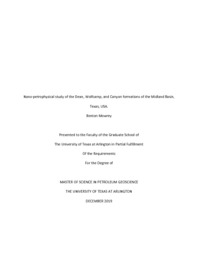
ATTENTION: The works hosted here are being migrated to a new repository that will consolidate resources, improve discoverability, and better show UTA's research impact on the global community. We will update authors as the migration progresses. Please see MavMatrix for more information.
Show simple item record
| dc.contributor.advisor | Hu, Qinhong | |
| dc.creator | Mowrey, Benton M | |
| dc.date.accessioned | 2022-07-14T12:37:25Z | |
| dc.date.available | 2022-07-14T12:37:25Z | |
| dc.date.created | 2019-12 | |
| dc.date.issued | 2019-12-05 | |
| dc.date.submitted | December 2019 | |
| dc.identifier.uri | http://hdl.handle.net/10106/30668 | |
| dc.description.abstract | The prolific levels of oil and gas production from the shale revolution have been plagued by steep initial production decline and inefficiencies in recovering the total hydrocarbons in place. Even the widespread practice of using multi-well sites with closely spaced wellbores has failed to yield a moderate fraction of the potential resources. It is hypothesized that the constraints of shale production arise from its nano-pore structure. Slow, diffuse hydrocarbon transport from the shale matrix to the stimulated fracture network is a likely production bottleneck. Understanding transport phenomena from this tight, porous matrix to the fracture via nanometer-scale pathways is essential to implementing effective recovery methods for tight shale plays. These fluid pathways are controlled by the pore size distribution, pore shape, and pore connectivity: nanometer scale properties that affect the macroscopic reservoir characteristics. This study aims to detail a variety of tests which can comprehensively characterize shale samples at the nanometer scale. Additionally, this study establishes limited pore connectivity, dual wettability, and diffuse transport as limitations on production from Dean, Wolfcamp, and Canyon formations.
Nanopetrophysical characteristics were investigated for a total of ten core samples from three wells in the Midland Basin’s Dean, Wolfcamp, and Canyon formations. Pore structure and transport properties were characterized using mercury injection capillary pressure, vacuum saturation, liquid pycnometry, spontaneous imbibition, and contact angle (wettability) tests. Additionally, geochemistry and mineralogical composition were assessed with total organic carbon (TOC), pyrolysis, and X-ray powder diffraction (XRD) testing. Samples were processed in the following forms: cores, one cubic centimeter cubes, crushed sediment, and thin slabs.
Spontaneous imbibition tests for each sample exhibit significant variance in imbibition rates with fluid wettability. Imbibition slopes are in the range of the classical diffusion value of 0.5 for hydrophobic fluid, and in the anomalous diffusion range of 0.25 for hydrophobic fluid; indicative of a connected oil-wet pore-throat system and a disconnected water-wet pore-throat system. Additionally, the presence of edge-accessible and isolated porosity was probed with vacuum saturation and liquid pycnometry. Pore systems appear to be limited by the extent of connectivity of pore space to the sample edge. The presence of edge-accessible pore space is important to shale because of very low permeability (nano-darcy to milli-darcy scale). Fluid flow through the pore system to hydraulically induced fractures may be limited by pore systems which are not accessible to the fracture edge. Mercury injection capillary pressure tests show a significant volume for Wolfcamp and Canyon samples that are dominated by large pore-throats (>100 µm), possibly associated with sheet-like pore space between laminae. Dean samples show more evenly-distributed pore-throats than the Wolfcamp and Canyon samples, dominantly between 0.01-1 µm. | |
| dc.format.mimetype | application/pdf | |
| dc.language.iso | en_US | |
| dc.subject | Shale | |
| dc.subject | Wolfcamp | |
| dc.subject | Canyon | |
| dc.subject | Dean | |
| dc.subject | Midland | |
| dc.subject | Connectivity | |
| dc.subject | Wettability | |
| dc.subject | Diffusion | |
| dc.subject | Imbibition | |
| dc.subject | Pore | |
| dc.subject | Structure | |
| dc.subject | Porosity | |
| dc.subject | Throat | |
| dc.subject | Distribution | |
| dc.title | Nano-petrophysical study of the Dean, Wolfcamp, and Canyon formations of the Midland Basin, Texas, USA. | |
| dc.type | Thesis | |
| dc.date.updated | 2022-07-14T12:37:25Z | |
| thesis.degree.department | Earth and Environmental Sciences | |
| thesis.degree.grantor | The University of Texas at Arlington | |
| thesis.degree.level | Masters | |
| thesis.degree.name | Master of Science in Earth and Environmental Science | |
| dc.type.material | text | |
| dc.creator.orcid | 0000-0001-7979-8403 | |
Files in this item
- Name:
- MOWREY-THESIS-2019.pdf
- Size:
- 3.216Mb
- Format:
- PDF
This item appears in the following Collection(s)
Show simple item record


